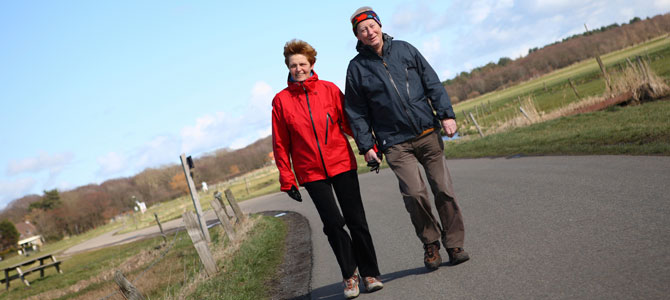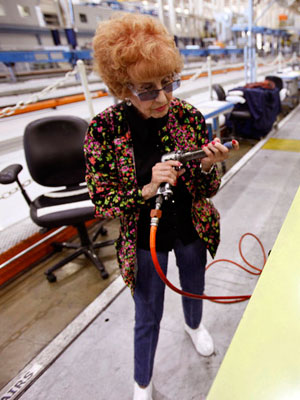For six decades, an unstoppable, unprecedented force of nature gathered speed and strength across America. Then, in an epic surge two years ago, the Silver Tsunami broke, sweeping the first giant wave of Baby Boomers into retirement age.
Never before has the nation included so many people aged 65. Today, they represent some 40.2 million people—or 13 percent of the total population—and the deluge continues, with another 10,000 Baby Boomers turning 65 every single day. By 2050, the age group will encompass some 88.5 million Americans.
Further strengthening the Silver Tsunami, not only do more people reach 65, but many others now live decades beyond that milestone. In the 20th century, factors like improved health care, living conditions, and workplace safety produced a dramatic increase in human life expectancy. In fact, the fastest growing segment of the older population (currently some 8.5 million people) consists of what geriatric specialists call the "old-old," those aged over 85.
Together, these cultural factors will test long-held ideas about what it means to grow old—and how society will be able to cope economically, medically, politically, and socially. Many Baby Boomers grew up as rock 'n' roll rebels fighting for feminism, civil rights, and an end to war. Will they want to go gently into that good night?
And, what awaits elderly people facing major health challenges? Many "old-old" adults suffer from Alzheimer's or some other kind of dementia, presenting extra difficulties for health care, social services, and family members. Plus, an aging population delivers its own harsh economic realities; for many people, retirement is an elusive dream, while working longer is a financial necessity.
In response to this personal and public sea-change, the University of Iowa is tackling the "grand challenge" of America's aging population. With its resources as a world-class research institution, teaching hospital, and liberal arts university, the UI supports many initiatives to prepare for the unprecedented times ahead. Across campus, doctors, nurses, lawyers, engineers, public health experts, and social scientists combine their expertise to smooth the American transition into the New Old Age.
Mind Matters
Exercise may be the last thing on elderly people's minds—but it turns out that keeping fit can actually protect their minds.
In a study with significance for older people and potential for the treatment of dementia, UI psychology professor Michelle Voss examines whether daily physical activity can improve people's ability to learn new things or prevent age-related memory difficulties such as recalling someone's name. Over the last year, some 50 older adults taking part in the study have worn gadgets on their wrists that track daily physical activity. Voss's team then checks if participants' activity levels are associated with better learning and memory.
In another study, the team uses functional magnetic resonance imaging (fMRI) to see how physical activity and exercise might produce these effects. One possibility supported by the data so far is that exercise improves the synchrony of brain networks that are disrupted in dementia.
"Most of us know that exercise can improve brain health indirectly—by improving many aspects of bodily health, such as cardiovascular function," says Voss. "But, research indicates there are a lot of positive effects of exercise on the brain well before you improve your fitness or lose weight from exercise."

To improve brain function, exercise doesn't have to be exhausting or daunting. Previous studies have shown that even moderate intensity activities, like brisk walking, can increase molecules that support the continual production of new neurons in the hippocampus. (This region is important for memory and typically shrinks with age, especially in people who develop Alzheimer's disease.) Exercise also seems to help different regions of the brain communicate with each other, a process that becomes more difficult with age.
Voss is a faculty member in the UI's Aging Mind and Brain Initiative (AMBI), established in 2010 as part of the UI's "cluster hire" initiative to recruit faculty in interdisciplinary groups to address some of society's most urgent concerns. Other cluster hires have focused on water sustainability, genetics, digital public humanities and fine arts, and obesity.
Since 2010, AMBI has hired 10 faculty members in the colleges of medicine, public health, nursing, engineering, and liberal arts and sciences. Often, they work collaboratively with their AMBI colleagues, as well as faculty and staff in other UI departments and external institutions like the Mayo Clinic. AMBI Director Matt Rizzo, 83R, 85F, summarizes the wide-ranging scope of initiatives as "from cell to soul."
"Aging is a complex problem—and there are many strategies for attacking it," he adds. "It's not just about exploring the molecular factors in disease but also about the delivery of health care at the community and societal level."
In other AMBI projects, researchers are working to map neural circuits in the brain, explore whether human genes can be modified to turn back the aging clock, improve hearing aid performance, increase the support of family members caring for people with Alzheimer's disease, and assess the best ways to adapt cars' new technology for elderly drivers.
"People want to be happy, productive members of society for as long as possible; they don't want to be in pain or a burden to their family or society," says Rizzo. "Aging's always been an issue, but as we learn more about the mechanisms of decline, it's more possible to intervene earlier and delay what seems to be the inevitable."
A Life's Work
 PHOTO: GENARO MOLINA/© LOS ANGELES TIMES
Well past retirement age, Elinor Otto keeps punching the clock.
PHOTO: GENARO MOLINA/© LOS ANGELES TIMES
Well past retirement age, Elinor Otto keeps punching the clock.
Every day, Elinor Otto awakens at 4 a.m. and heads to her job as a riveter at a California aircraft assembly plant. It's just as well she loves her work—Elinor Otto is 93 years old.
One of the original, groundbreaking "Rosie the Riveter" women who kept factories running during World War II, Otto made headlines recently when news broke of her incredibly long career. She may seem like an anomaly, but Otto offers a glimpse into a future when many more Americans will continue to work long after they qualify for Social Security.
By 2020, according to the Bureau of Labor Statistics, 28 percent of women and 35 percent of men aged 65-74 will remain in the workforce. Some, like Otto, will do so because they enjoy their jobs and the social connections, like to stay busy, or feel a sense of purpose. But others face extended careers because they have no other choice financially.
"[The Baby Boomer] generation gets an extra 30 years of life that their parents didn't have. That's having a huge impact on workplaces," says Brian Kaskie, a professor in the UI College of Public Health who also serves as associate director for public policy in the UI Center on Aging . Established in 1990, the center takes an interdisciplinary approach to advance aging-related education, health care, public policy, and research—including how to accommodate and respond to an aging workforce.
With so many Baby Boomers working longer or approaching retirement, companies can't afford to wait to develop programs and policies to deal with these issues, says Kaskie. Universities are at the front of the aging workers boom, particularly in terms of faculty members, and the lessons they learn can be adapted by other professions and industries. Toward that end, Kaskie led a recent project—the "Iowa Study on Promoting Healthy and Successful Aging within Academic Institutions"—that surveyed some 180 public and private universities in search of best practices in workplace wellness and retirement readiness.
The study identified measures to keep older people engaged, productive, and safe at work, such as wellness programs, ergonomically designed environments, flexible schedules, and support with caregiving for family members—strategies that ultimately benefit staff of all ages.
Helping older people retain jobs is good for companies that would otherwise face an enormous loss of knowledge and experience when workers retire. In terms of helping staff get ready for retirement, Kaskie says, "Giving someone a gold watch and telling them to get on with retirement just doesn't cut it anymore."
To help employees prepare for the practical side of leaving work, employers can offer financial education about retirement savings, Medicare, and long-term care. Job-sharing and phased retirement options are also good ways to help someone adjust gradually to this major life change. Beyond the financial aspects, retirement can come as a profound psychological shock, especially for people whose sense of self-worth and identity has been tied to their jobs for decades.
To reduce such stresses, it helps to start thinking early about life after retirement, planning ways to make the extra years productive and happy. Maintaining a good work-life balance throughout a career makes it easier to devote more time to established leisure activities after retirement.
"Instead of seeing retirement as a loss, it's better to view it as an opportunity," says Kaskie. "Whether you embark upon a second career or explore volunteer opportunities, you need to plan for this next stage of your life."
Changing Attitudes
 PHOTO: Rick Floyd/NBC/NBCU Photo Bank/getty images
Actress Betty White throws a pie in the face of stereotypes about older people.
PHOTO: Rick Floyd/NBC/NBCU Photo Bank/getty images
Actress Betty White throws a pie in the face of stereotypes about older people.
Long-running television shows The Brady Bunch and Leave It To Beaver helped shape the attitudes and cultural norms of countless American children, but their representations of happy family and social life omitted one important component: realistically depicted grandparents and other elders. In fact, such seniors were conspicuous by their absence. No wonder former Florida Senator Claude Pepper once compared older people to "the lepers of television, ostracized from public view."
Since Pepper's work in the 1970s and '80s as a leading national activist for older people, the situation has improved, through modern depictions like Everybody Loves Raymond and the crossgenerational appeal of 91-year-old actress Betty White. But, according to UI social work professor Mercedes Bern-Klug, 82BA, 84MSW, more needs to be done to counter outdated stereotypes.
"Some older people deal with chronic illness and compromised physical and mental abilities that require the help of others, but most don't. They're living independently, not in nursing homes," she says. "Both these groups of older adults have important perspectives to offer society."
Bern-Klug points out the broad variation in experiences in older adulthood. Some people use this time to devote attention to activities they'd put on the back-burner earlier in life, while others take up new interests and sometimes new adventures.
Through the College of Liberal Arts and Sciences' Aging Studies Program that she directs, Bern-Klug helps UI students discover the multidimensional complexity of old age. Through courses that address psychological, biological, health, social, and cultural aspects, students learn that aging is a natural process—not a disease to be feared.
They discover that old age is rich, complex, and can span 40 years—far longer than any other part of our lives. Too often, though, elderly adults are lumped together in the dismissive, catchall category of "old," which ignores the differences in their physical, emotional, and psychological needs. "We'd never think that 4- and 40-year-olds have the same needs," says Bern-Klug, "but we do with 60- and 100-year-olds, despite their 40-year age difference."
Such distinctions are important because, regardless of their eventual career, these UI students will be working with aging adults—or on issues related to them—more than ever before. "I'd love for all students who graduate from this university to take at least one course on aging to enhance their cultural competence," says Bern-Klug. "It's important that they graduate with skills and attitudes preparing them to work with people who've lived 70, 80, or 90 years."
Plus, as most of today's students will likely live longer than their own grandparents, Bern-Klug wants to instill in them a sense of appreciation for their own aging process, so they approach it with wonderment and hope. "Older adulthood is different from youth—not worse or better," she says. "We don't take older adulthood seriously enough and look at what it has to offer."
Improving Care

"Have you taken your medication, dear?" "How are you feeling today, sweetie?" Such endearments directed toward elderly people seem like a simple expression of care and sympathy—but these innocuous terms can produce a surprisingly negative reaction.
Through her research, UI nursing professor Kristine Williams identified that such belittling baby talk, which she calls "elderspeak," resulted in twice as many instances of aggressiveness or resistance to care by elderly people with dementia.
Williams' research is typical of the kind of transformative knowledge emerging from the Hartford Center of Geriatric Nursing Excellence (HCGNE) in the UI College of Nursing , where she is a co-director. One of only eight such specialized academic institutes in the nation, the center trains nurse scientists and clinicians to discover, teach, and apply the best care for older people—ultimately improving their quality of life.
The center's research initiatives are wide-ranging, including how to identify depression in older adults, treat pain and incontinence in nursing home residents, and facilitate the adoption of new evidence-based care by staff in nursing homes and assisted-living facilities. One unusual program sends UI nursing students to local nursing homes to run storytelling sessions with residents. Timeslips is a national initiative to help people with dementia by "replacing the pressure to remember with the freedom to imagine," and the program's fun, improvisational techniques unleash seniors' creativity.
"Memory isn't everything—there are other dimensions to people," says HCGNE director Janet Specht, 73BSN, 81MA, 96PhD. "It's exciting to help destroy myths that people with dementia are just empty shells waiting to die. This project shows that they may have lost some functional abilities but they can still do things."
Another of the center's goals is to break down misperceptions about old age and to help young nurses see the enriching possibilities inherent in caring for older people. Unused to being around or interacting with older adults, many student nurses are initially unsure even what to say. To their surprise and delight, they discover that a multitude of life experiences provides plenty of conversation topics and that age burnishes personality.
Each year, Specht gives her students an assignment: to draw a portrait of themselves as "old," noting their future age. Five years ago, students equated old with being 65, and they typically drew themselves as alone, sad, and in poor health. Now, they say that old age begins at 85, 90, or even 100 and they draw themselves as vibrant, lively, and socializing with others.
Seeing past the stereotypes, they're picturing the reality of the new old age.

